Understanding the problem
There are many conditions that can affect the feet from fungal or viral infections, dry skin and deformities to pressure points and pain.
Conditions that affect the feet
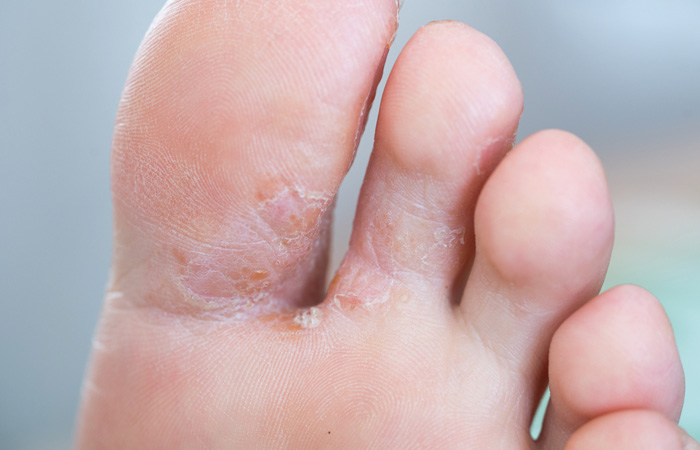
Athlete’s foot flourishes in the warm, moist environment between the toes. It is often picked up from damp changing rooms and swimming pool floors.
Symptoms usually start between the fourth and fifth toes and the skin appears red and itchy, later becoming white, inflamed and weepy. It may also crack and peel and, if left untreated, can spread to other areas of the foot and toenails.
If infection spreads to the nail, it may look thickened or discoloured at fir...
Athlete’s foot flourishes in the warm, moist environment between the toes. It is often picked up from damp changing rooms and swimming pool floors.
Symptoms usually start between the fourth and fifth toes and the skin appears red and itchy, later becoming white, inflamed and weepy. It may also crack and peel and, if left untreated, can spread to other areas of the foot and toenails.
If infection spreads to the nail, it may look thickened or discoloured at first. If the infection gets worse, white or yellow patches can appear where the nail has come away from the nail bed. The nail may also become soft and crumble and the skin next to it may be inflamed or scaly.
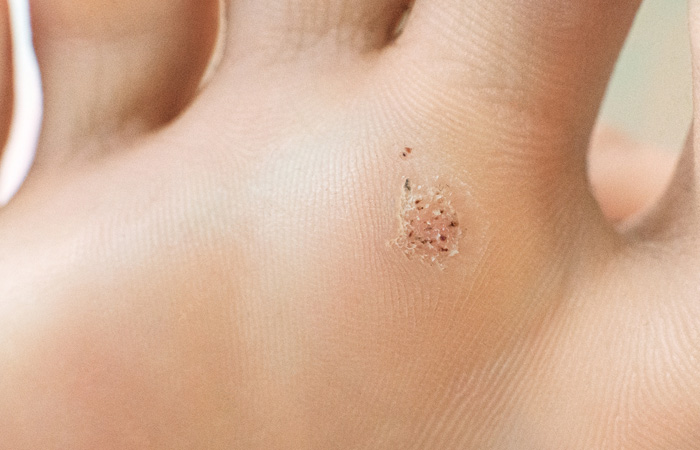
A verruca (plantar wart) is caused by the human papilloma virus (HPV), which gets into the skin through a minor cut or abrasion. They appear as flattened, discreet lesions, usually on the ball of the foot, the underside of the big toe or the heel, either alone or in dusters. Multiple small black spots may be visible on the verruca, which are caused by bleeding in small blood vessels. Verrucas can be tender when squeezed and may cause discomfort when walking.
A verruca (plantar wart) is caused by the human papilloma virus (HPV), which gets into the skin through a minor cut or abrasion. They appear as flattened, discreet lesions, usually on the ball of the foot, the underside of the big toe or the heel, either alone or in dusters. Multiple small black spots may be visible on the verruca, which are caused by bleeding in small blood vessels. Verrucas can be tender when squeezed and may cause discomfort when walking.
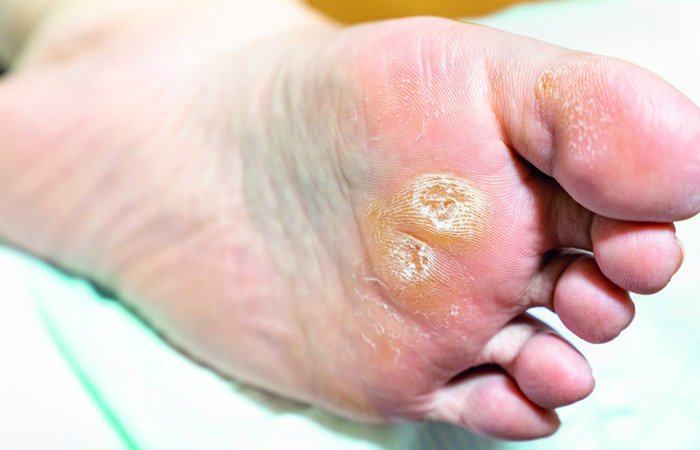
Corns are caused by rubbing or pressure from ill-fitting shoes. Hard corns are layers of dead skin that build up on the tops of toes and the outside of the little toes. The base of the corn is on the skin’s surface with the tip pointing inwards, pressing on nerve endings and causing pain. Soft corns are white, rubbery lumps found between the toes.
Calluses are caused by friction and pressure when the skin rubs against shoes or the ground. These have no centre and are less...
Corns are caused by rubbing or pressure from ill-fitting shoes. Hard corns are layers of dead skin that build up on the tops of toes and the outside of the little toes. The base of the corn is on the skin’s surface with the tip pointing inwards, pressing on nerve endings and causing pain. Soft corns are white, rubbery lumps found between the toes.
Calluses are caused by friction and pressure when the skin rubs against shoes or the ground. These have no centre and are less sharply defined than corns. They commonly appear on the ball of the foot, the outside of the big toe and the sides of the heel. They produce a burning sensation, are yellowish in colour and are hard and rough.
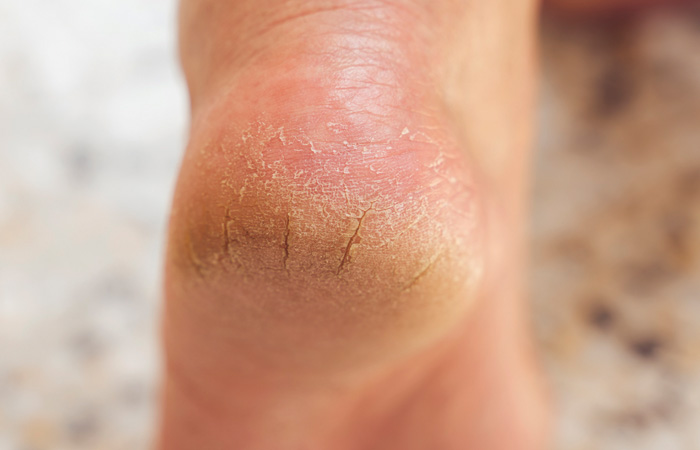
If the skin on the heels is particularly dry, it becomes thickened, hard and less flexible. When walking, pressure is put on the heel, causing the skin to stretch and spread out. If the skin is too inflexible to stretch, it will crack.
Symptoms include dry, scaly areas of skin and vertical cracks or splits in the heel. In severe cases, the cracks may bleed or become inflamed or infected.
If left untreated, cracked heels can lead to prolonged pain and discomfort. Cr...
If the skin on the heels is particularly dry, it becomes thickened, hard and less flexible. When walking, pressure is put on the heel, causing the skin to stretch and spread out. If the skin is too inflexible to stretch, it will crack.
Symptoms include dry, scaly areas of skin and vertical cracks or splits in the heel. In severe cases, the cracks may bleed or become inflamed or infected.
If left untreated, cracked heels can lead to prolonged pain and discomfort. Cracks could also deepen resulting an open wound that leaves an indidivual at risk of contracting cellulitis. For those with diabetes, cracked heels can also lead to foot ulcers.
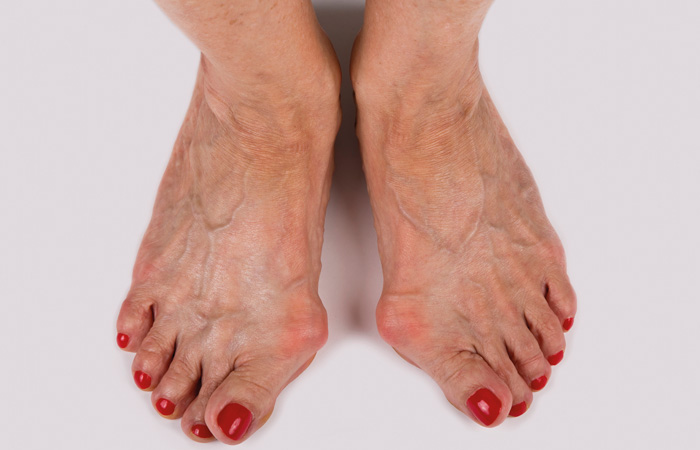
A bunion is a bone deformity of the joint at the base of the big toe. The toe will point inwards and force the bone to stick out. The cause is unknown but is thought to be linked to family history and wearing ill-fitting shoes can worsen the condition.
A bunion is a bone deformity of the joint at the base of the big toe. The toe will point inwards and force the bone to stick out. The cause is unknown but is thought to be linked to family history and wearing ill-fitting shoes can worsen the condition.
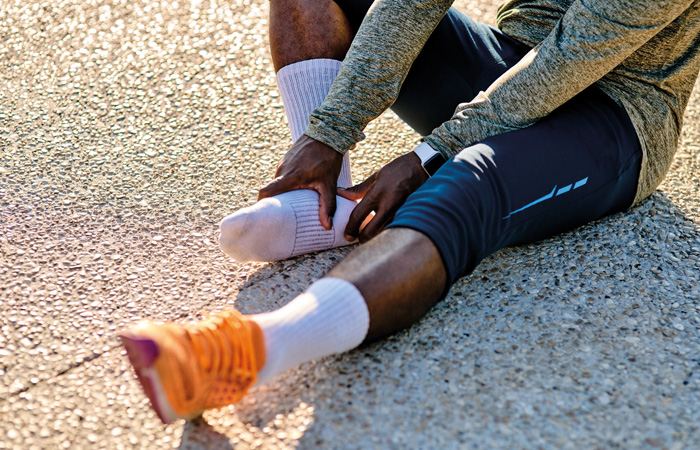
The most common cause of heel pain is plantar fasciitis – inflammation of the plantar fascia ligament that supports the arch of the foot and also acts as a shock absorber. It is often described as a stabbing or aching pain about 4cm forward from the heel, although it can occur anywhere on the underside of the heel. It may be tender to touch and is often worse when walking first thing in the morning or after long periods of rest.
The most common cause of heel pain is plantar fasciitis – inflammation of the plantar fascia ligament that supports the arch of the foot and also acts as a shock absorber. It is often described as a stabbing or aching pain about 4cm forward from the heel, although it can occur anywhere on the underside of the heel. It may be tender to touch and is often worse when walking first thing in the morning or after long periods of rest.
When to refer
- If the customer has diabetes as they are more susceptible to further complications
- If athlete’s foot has persisted after treatment
- If any condition involves weeping skin
- If symptoms may be due to an infection (e.g. if the foot is hot and painful).
